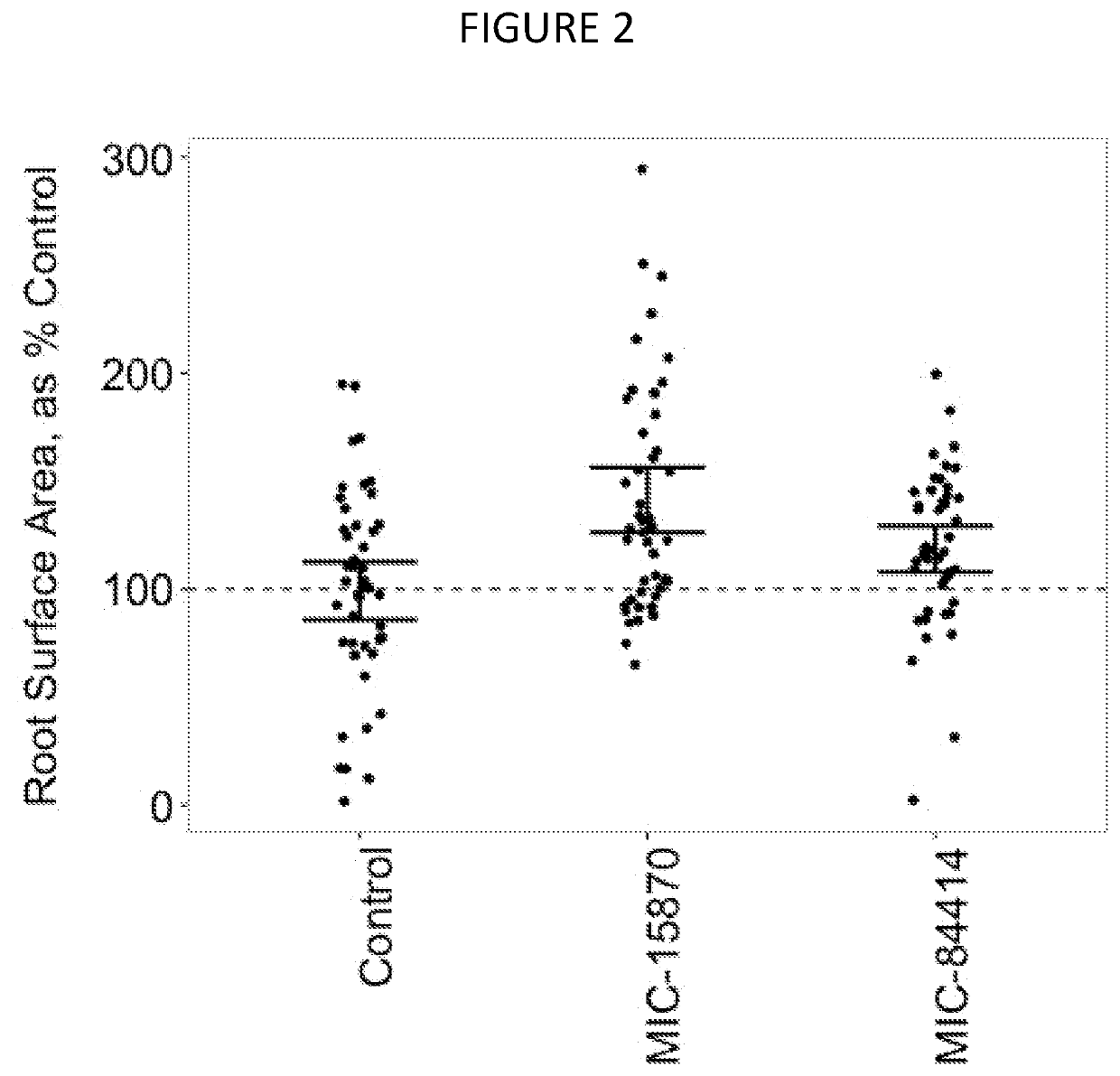Endophyte compositions and the methods for improvement of plant traits
a technology of endophyte composition and plant traits, which is applied in the field of compositions and methods for improving plant traits, can solve the problems of many gm traits that cannot be accepted in the global market, and many synthetic chemistries are excluded from some global markets, so as to improve a trait of agronomic importance and increase the biomass of dry roots
- Summary
- Abstract
- Description
- Claims
- Application Information
AI Technical Summary
Benefits of technology
Problems solved by technology
Method used
Image
Examples
example 1
Isolation and Identification of Endophytes
[0895]Isolation and cultivation of endophytic microbes from agricultural plants was performed using methods well known in the art. MIC-15870 was isolated from the roots of Zea mays domesticated variety B73. MIC-84414 was isolated from Bouteloua gracilis seed. MIC-68000 was isolated from the seeds of a Zea mays local to the southwestern United States. DNA was extracted from the ground tissues using the DNeasy DNA extraction kit (Qiagen, Hilden, Germany) according to the manufacturer's instructions. The endophytes were characterized by the sequences of genomic regions, these sequences are listed in Table 4. Primers that amplify genomic regions of the endophytes of the present invention are listed in Table 3. Additional isolation and cultivation of endophytic microbes from agricultural plants was performed using methods well known in the art. MIC-99023 was isolated from Platycladus orientalis tissue. MIC-19994 was isolated from Platycladus orie...
example 2
Isolation and Identification of Endophytes Using Marker Gene Sequences
[0901]Bacterial endophytes described herein were further characterized by the sequence of the marker gene elongation factor G. PCR amplification of the elongation factor G gene using primer sequences fusA-f2 (SEQ ID NO: 30) and fusA-r2 (SEQ ID NO: 31) is described in Miyoshi-Akiyama T, Hayakawa K, Ohmagari N, Shimojima M, Kirikae T (2013) Multilocus Sequence Typing (MLST) for Characterization of Enterobacter cloacae. PLoS ONE 8(6): e66358. doi:10.1371 / journal.pone.0066358. The sequence of elongation factor Gin MIC-82330 is SEQ ID NO: 49.
[0902]Endophytes described herein can be identified by the sequence of one or more of the following loci: long subunit rRNA (LSU), small subunit rRNA (SSU), second largest subunit of RNA polymerase II (RPB2), beta-tubulin, 60S ribosomal protein L 10. PCR amplification of the LSU using primer sequences LROR (SEQ ID NO: 26 and SEQ ID NO: 26) and LR5 (SEQ ID NO: 27 and SEQ ID NO: 27) ...
example 3
Isolation and Identification of Bacterial and Fungal Endophytes
[0904]Classification of the bacterial strains using its 16S sequence was done by the following methodology.
[0905]To accurately characterize isolated bacterial endophytes, colonies were submitted for marker gene sequencing, and the sequences were analyzed to provide taxonomic classifications. Colonies were subjected to 16S rRNA gene PCR amplification using a primer pair 27f (5′-AGAGTTTGATYMTGGCTCAG-3′) (SEQ ID NO: 1) and 1492r (5′-GGTTACCTTGTTACGACTT-3′) (SEQ ID NO: 2). Sequencing reactions were performed using primers: 27f (5′-AGAGTTTGATYMTGGCTCAG-3′) (SEQ ID NO: 1), 515f (5′-GTGYCAGCMGCCGCGGTAA-3′) (SEQ ID NO: 3), 806r (5′-GGACTACNVGGGTWTCTAAT-3′) (SEQ ID NO: 4), and 1492r (5′-GGTTACCTTGTTACGACTT-3′) (SEQ ID NO: 2). Preferably sequencing primers are chosen so that overlapping regions are sequenced. Sanger sequencing of was performed at Genewiz (South Plainfield, N.J.). Raw chromatograms were converted to sequences, and ...
PUM
| Property | Measurement | Unit |
|---|---|---|
| temperature | aaaaa | aaaaa |
| temperatures | aaaaa | aaaaa |
| temperatures | aaaaa | aaaaa |
Abstract
Description
Claims
Application Information
 Login to View More
Login to View More - R&D
- Intellectual Property
- Life Sciences
- Materials
- Tech Scout
- Unparalleled Data Quality
- Higher Quality Content
- 60% Fewer Hallucinations
Browse by: Latest US Patents, China's latest patents, Technical Efficacy Thesaurus, Application Domain, Technology Topic, Popular Technical Reports.
© 2025 PatSnap. All rights reserved.Legal|Privacy policy|Modern Slavery Act Transparency Statement|Sitemap|About US| Contact US: help@patsnap.com


